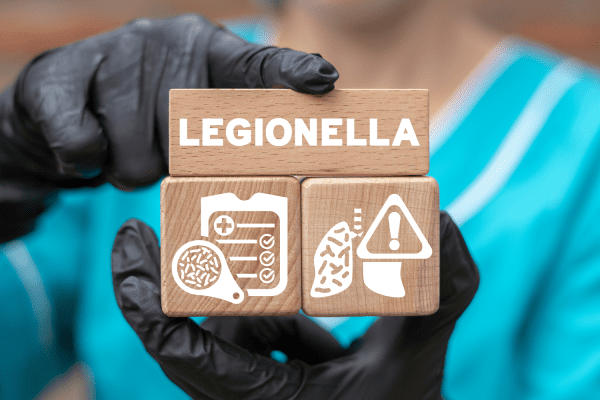
Legionella is a type of bacteria that can cause a serious and potentially life-threatening form of pneumonia called Legionnaire’s disease. The bacteria are found naturally in water and can grow and multiply in systems such as cooling towers, hot water tanks, and large plumbing systems. When these systems are not properly maintained and disinfected, the bacteria can thrive and be spread through the air in the form of small droplets or mist. Facility managers in charge of water system maintenance to prevent Legionella need an experienced, trusted partner to aid with testing and preventive treatment to keep these systems safe from bacteria, a partner like ChemREADY.
Government health agencies estimate that 25,000 people in the United States develop Legionnaire’s disease each year. And scientists continue to isolate and identify new species of legionella bacteria. In fact, researchers at the Laboratory of Environmental Microbiology and Molecular Biology (Mab) at the University of Bologna, identified a new stain in January 2023, the 64th identified worldwide. The identification and its pattern of antibiotic resistance helps create public health strategies and prevention measures designed to protect the public.
People can contract Legionnaire’s disease by inhaling these contaminated droplets or mist emitted from improperly maintained building water systems, or systems. Other times, ordinary processes within a building’s water system can reduce the amount of available disinfectant and Legionella and other bacteria can proliferate without regular system testing. The disease can also be contracted by aspirating contaminated water into the lungs, although this is less common. People who are at a higher risk of contracting Legionnaire’s disease include those who are over 50 years old, smokers, heavy drinkers, and those with weakened immune systems or underlying health conditions.
Symptoms of Legionnaire’s disease include fever, chills, cough, shortness of breath, muscle aches and headache. In severe cases, the disease can lead to respiratory failure, septic shock, and even death. The Centers for Disease Control and Prevention (CDC) estimates that between 8,000 and 18,000 people are hospitalized with Legionnaire’s disease in the United States each year.
There are several ways to prevent the growth and spread of Legionella bacteria in water systems, with the best, proactive approach including a water management plan. These include maintaining the proper temperature and pH of the water, regularly cleaning and disinfecting the system, and possibly using supplemental disinfection chemicals such as chlorine, chlorine dioxide, or to kill the bacteria. It is also important to regularly test the water for Legionella to ensure that it is not present in the system.
There are also several measures that can be taken to reduce the risk of contracting Legionnaire’s disease. These include avoiding inhaling mist or vapor from hot tubs, spas, and showers, and avoiding drinking water from sources that may be contaminated with the bacteria. It is also important to maintain good hygiene and to promptly seek medical attention if you develop symptoms of the disease.
There are several steps that facilities such as hotels, hospitals, and nursing homes can take to prevent the growth and spread of Legionella in their water systems. These include regularly maintaining and cleaning the systems, testing the water for the presence of the bacteria, and implementing appropriate disinfection protocols. It is also important for these facilities to have a plan in place to quickly and effectively respond to a Legionella outbreak to minimize the risk of transmission to guests or residents. ChemREADY has assisted many healthcare facilities to create water treatment plans. A water treatment plan can help facilities remain compliant with standards issued by the Joint Commission and the Centers for Medicare and Medicaid Services.
In addition to preventing the growth and spread of Legionella in water systems, it is also important to be aware of the potential for the bacteria to be present in other types of systems such as cooling towers and humidifiers. These systems can also be sources of Legionella if they are not properly maintained and disinfected.
Overall, it is important to be aware of the potential risks associated with Legionella and to take steps to prevent the growth and spread of bacteria in water systems. By following proper maintenance and disinfection protocols, facilities can protect their guests, residents, and employees from the serious and potentially life-threatening consequences of Legionnaire’s disease.
ChemREADY offers complete legionella water treatment services, from testing through risk assessment and disinfection. We can help guide your documentation of activities and record keeping that outlines corrective actions. Talk to our Legionella experts at ChemREADY to ask us about risk assessments for your facility and available disinfection products suited and scaled for your water systems. We can help reduce the risk of Legionella to avoid the disastrous consequences of a Legionnaires’ outbreak. Call ChemREADY today.
Ben Frieders is the Business Development and Marketing Manager at ChemREADY, an industrial water treatment company, where he focuses on driving growth through strategic marketing, business development, and acquisitions. A former U.S. Navy Chief Petty Officer with a background in nuclear operations, Ben brings a unique blend of technical expertise and leadership to the water treatment industry. Certified in ASSE 12080 Legionella Water Safety and Management, he is a recognized expert in water quality standards, regulatory compliance, and Legionella risk management. Passionate about scaling businesses and optimizing systems, Ben combines data-driven strategies with a hands-on approach to help organizations achieve sustainable growth.